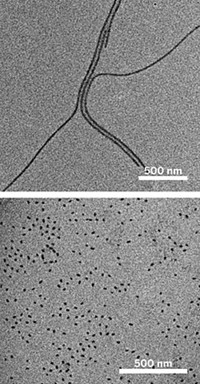Advertisement
Grab your lab coat. Let's get started
Welcome!
Welcome!
Create an account below to get 6 C&EN articles per month, receive newsletters and more - all free.
It seems this is your first time logging in online. Please enter the following information to continue.
As an ACS member you automatically get access to this site. All we need is few more details to create your reading experience.
Not you? Sign in with a different account.
Not you? Sign in with a different account.
ERROR 1
ERROR 1
ERROR 2
ERROR 2
ERROR 2
ERROR 2
ERROR 2
Password and Confirm password must match.
If you have an ACS member number, please enter it here so we can link this account to your membership. (optional)
ERROR 2
ACS values your privacy. By submitting your information, you are gaining access to C&EN and subscribing to our weekly newsletter. We use the information you provide to make your reading experience better, and we will never sell your data to third party members.
Materials
Hollow Hybrid
Nanomaterials integrate dendrimers with periodic mesoporous silicas
by MICHAEL FREEMANTLE
November 29, 2004
| A version of this story appeared in
Volume 82, Issue 48

NANOCOMPOSITES
In work that has potential for drug delivery and gas storage, chemists at the University of Toronto have synthesized hybrid materials with ordered nanometer-wide channels and with channel walls that are composed of interconnected silicon-containing dendrimer building blocks.
Postdoc Kai Landskron and chemistry professor Geoffrey A. Ozin prepared the materials, which they call "periodic mesoporous dendrisilicas," by self-assembly of carbosilane-type dendrimers around a template [Science, 306, 1529 (2004)].
"The main advantage of using carbosilane-type dendrimers as precursors to hybrid mesoporous sieves is that it allows one to control not only the content of the organic functional groups precisely--that is, the silicon-to-carbon ratio--but also the local architecture within the mesoporous walls," comments Andreas Stein, chemistry professor at the University of Minnesota, Twin Cities. "The local connectivity is predesigned into the building blocks and appears to be largely maintained in the templated products."
Landskron and Ozin synthesized the building blocks by ethanolysis of Si[(C2H4)SiCl3]4 and related compounds. They then hydrolyzed and condensed the dendrimers around a cylindrical template.
"We use ionic surfactants or triblock copolyethers as templates," Landskron explains. "The dendrimers carry a polymerizable triethoxysilyl group. Upon polymerization around the template, an ordered template-polydendrimer nanocomposite is formed." The template is extracted with an organic solvent to give the ordered mesoporous polydendrimer.
"We expect the materials to find utility as a new generation of controlled chemical and pharmaceutical storage-and-release materials, heterogeneous catalysts, and chromatographic devices, as well as microelectronics packaging materials," Ozin says.





Join the conversation
Contact the reporter
Submit a Letter to the Editor for publication
Engage with us on Twitter